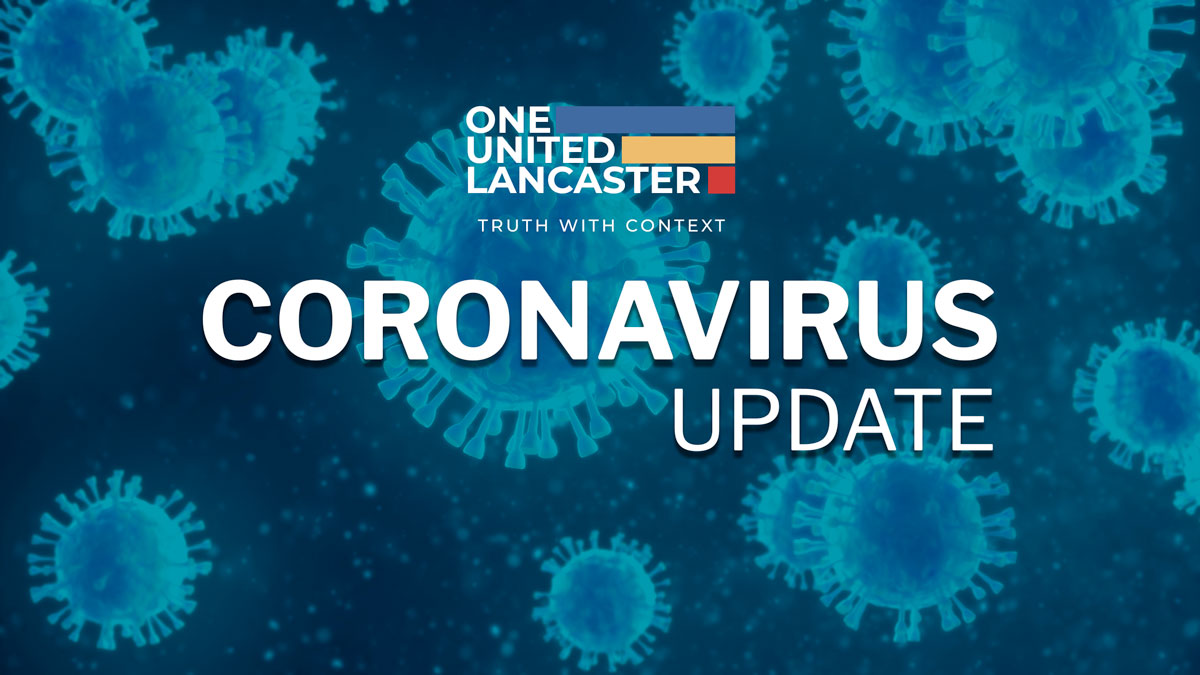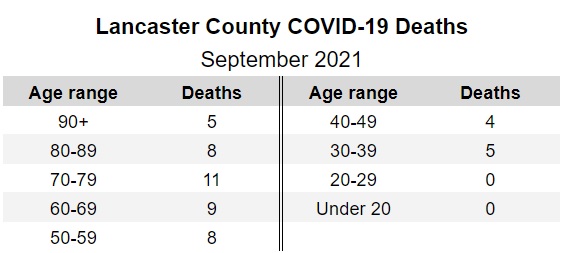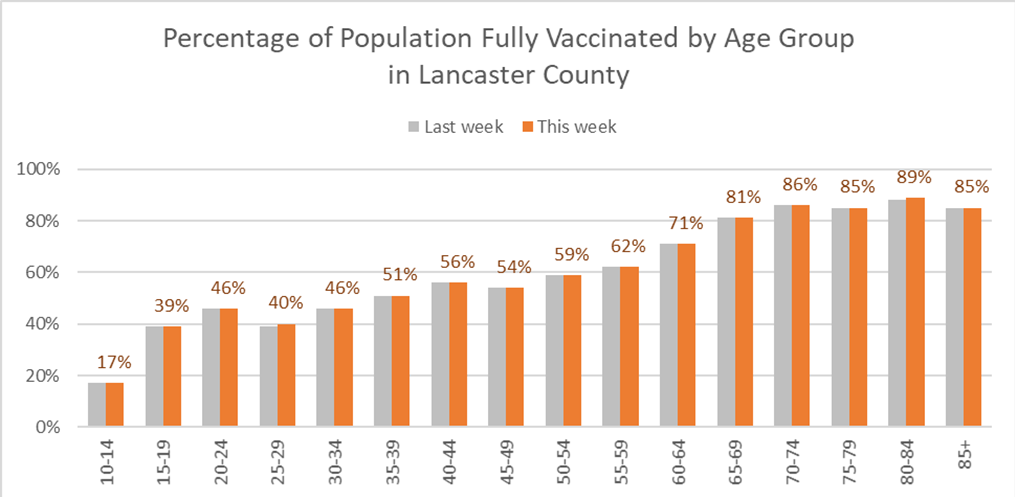
The COVID-19 virus continued to surge in Lancaster County throughout September, killing 47 residents, about three victims every two days.
While some parts of the nation are seeing a decline in the late autumn's pandemic strength, that trend has not yet emerged here.
The September death rate was the highest since June 2020, when 49 died, but far fewer than the 207 who died in December, the peak of the pandemic.
For the first time, more victims were under age 70 (26) than were 70 or above (24), a clear indication that the now dominant Delta variant is seriously attacking more younger people than the original COVID virus.
Five of those who died were millennials in their 30s. Previously that age category saw few deaths – one in June and only four others through the first 14 months of the pandemic.
While detailed studies are not yet available, “There is a feeling that the Delta variant (of COVID-19) targets a younger mix than the original virus did,” Dr. Stephen Diamantoni, the county coroner, said.
Intensive care unit doctors have told Diamantoni they are “seeing a significant increase of patients in their 30s and 40s who are really sick.”
At the same time, the number of elderly victims, those in their 80s and 90s, has steeply declined, most likely the result of 80%-plus vaccination rates among those age groups.
For the record, here are the deaths among all age ranges in September:

Early in the year, the Centers for Disease Control & Prevention said the Pfizer and Moderna vaccines were about 94% effective in preventing serious hospitalization or death. That trial data seems to have proven accurate here.
“Almost all those who died (here) were unvaccinated,” Dr. Diamantoni said, “well over 90%.”
Diamantoni attributed the resurgence of the virus to the Delta variant and to an easing of personal safety measures.
“I think that people have become lax with hand washing and mask wearing,” he said. “And a lot of unvaccinated people are comingling with the vaccinated.”
Hospital cases
Throughout September, the number of county residents hospitalized with COVID-19 increased steadily from 69 to 108, according to the state Health Department. On average, there were about 89 COVID patients daily in the county’s three hospitals.
The county has seen that rate of serious illness – a daily case average in the 80s – twice before during seasonal transitions: in April when the virus was receding toward summer lows and last November when it was headed to its December peak.
The state health department is unable, or unwilling, to provide information on the percentage of COVID patients who are vaccinated and unvaccinated, information that would inform residents of the value of vaccines.
But Penn Medicine Lancaster General Health, the county’s largest hospital, does provide that information. On Sept. 30, it reported:
- 54 of its 69 COVID patients (78%) were unvaccinated.
- 13 of 14 patients in intensive care (93%) were unvaccinated.
- 6 of 6 patients on ventilators (100%) were unvaccinated.
These rates are consistent with the predicted rates of vaccine protection. (More on that below.)
Where the virus is most active
Medical workers reported 6,102 positive COVID tests in the county in September, an average of 203 per day. That was the highest number since January, when there were 6,746 reported cases, an average of 218 per day. (At the peak of the pandemic, in December, there were 11,304 cases, an average of 365 per day.)
The five ZIP code areas with the highest number of positive tests were:
- Lancaster 17603: 535 cases
- Lancaster 17602: 478 cases
- Lititz 17543: 444 cases
- Ephrata 17522: 434 cases
- Elizabethtown 17022: 389 cases
Two rural communities, Bainbridge and Reinholds, had the greatest concentration of cases, both about 15 per 1,000 residents.
In a special report on children, the state Health Department said there were 48 children ages 0-4 and 355 youth ages 5 to 18 who tested positive in the week of Sept. 22-28.
Over the past six weeks that the department has tracked child cases, 355 children ages 0-4 and 1,714 children ages 5 to 18 contracted COVID-19 in this county.
Nursing and personal care homes
In the county personal care and nursing homes, once the epicenter of the pandemic, cases and deaths remained low in September.
There were no deaths at personal care homes. Three nursing homes – The Glen at Willow Valley, Masonic Homes, and Zerbe Retirement Community – reported one death each, according to the Centers for Medicare & Medicaid Services.
Four personal care facilities reported a total of 11 cases among their residents: Homestead (7), Providence Place (1) , Landis Homes (2) and Ephrata Manor (1).
Nine homes reported a total of 22 cases among their staff: Homestead (6), Garden Spot (1), Calvary Homes (1), Landis Homes (3), Meadow Ridge at Willow Valley (4), Mennonite Home (2), Providence Place (2), Long Community (1) and Quarryville Presbyterian (1).
Data for county nursing homes, provided by the state Health Department, were incomplete. They indicated about 32 resident cases and 78 staff cases through the first 19 days of the month among all those reporting.
Vaccination rates
About 56% of county residents are fully vaccinated, according to the state health department. Another 4% are partially vaccinated. Among those age 70 and older, about 85% are fully vaccinated. Full vaccination rates decline with age.

Lancaster’s 60% rate of partial and complete vaccination ranks 23rd highest among Pennsylvania’s 67 counties. Among neighboring counties, Lancaster’s rate is higher than York (58%) and Lebanon (54%) counties. But it trails Berks (61%) and Chester (75%) counties. The statewide average is 63%.
Booster shots
In mid-September, the U.S. Food & Drug Administration approved third-dose Pfizer booster shots for those most susceptible to COVID – people 65 and over, nursing home residents and those with immune system deficiencies.
A FDA advisory committee will meet Oct. 14 and 15 to consider approval of Moderna and Johnson & Johnson booster shots. It also will consider the advisability of giving individuals booster vaccines that differ by manufacturer from the primary vaccines they previously received.
Interestingly, when the FDA considers the Moderna booster, it may recommend a half dose, according to the Bloomberg news service and other media reports.
The rationale for that recommendation is revealing:
The Pfizer vaccines comes in 30-microgram doses. The Moderna vaccine comes in 100-microgram doses, more than three times stronger than Pfizer.
An FDA study, released in September, found that effectiveness of the Pfizer vaccine in reducing the risk of hospitalization fell from 91% initially to 77% after four months.
The Moderna vaccine reduced hospitalization risk by 93% initially and stayed 92% effective after the first four months.
Reducing the Moderna booster to 50 micrograms would sustain its protection in coming months but make more doses available internationally, Bloomberg reported.
How many breakthrough cases are there?
Reporting on the prevalence of breakthrough cases – people who contract COVID after vaccination – can easily be misunderstood.
Some news reports focus on the vaccination status of hospitalized COVID patients. They compare the percentage of unvaccinated patients (often 70% or 80%) to the number of unvaccinated patients (20% or 30%).
That comparison, however, is not the breakthrough rate. It does not indicate the likelihood that a vaccinated person will come down with COVID.
To calculate the breakthrough rate, one must compare the number of ill vaccinated persons to the total number of vaccinated persons.
The CDC does not report those statistics. But many states, including Pennsylvania, do.
The Kaiser Family Foundation surveyed those states and provided a summary of their reports. It found:
• The rate of breakthrough cases among those fully vaccinated is below 1% in all reporting states, ranging from 0.01% in Connecticut to 0.54% in Arkansas.
• The hospitalization rate among fully vaccinated people with COVID-19 ranged from effectively zero (0.00%) in California, Delaware, D.C., Indiana, New Jersey, New Mexico, Vermont, and Virginia to 0.06% in Arkansas.
• The rates of death among fully vaccinated people with COVID-19 were effectively zero (0.00%) in all but two reporting states, Arkansas and Michigan where they were 0.01%.
This summary has been compiled from records of the Lancaster County Coroner’s Office, the state Health Department, the Centers for Medicare & Medicaid Services, the Centers for Disease Control & Prevention and the U.S. Department of Health & Human Services by researcher Erica Runkles, sociologist Dr. Mary Glazier, data programmer Penn Glazier and journalist Ernest Schreiber.





